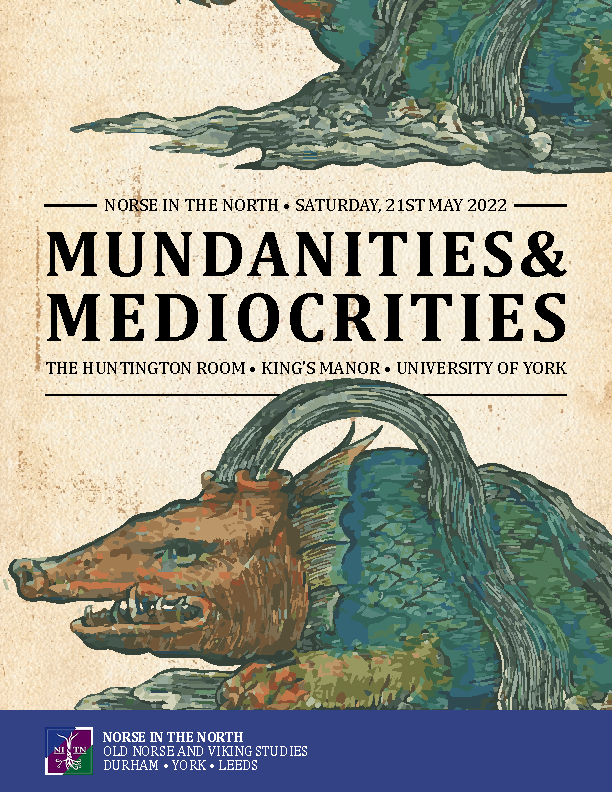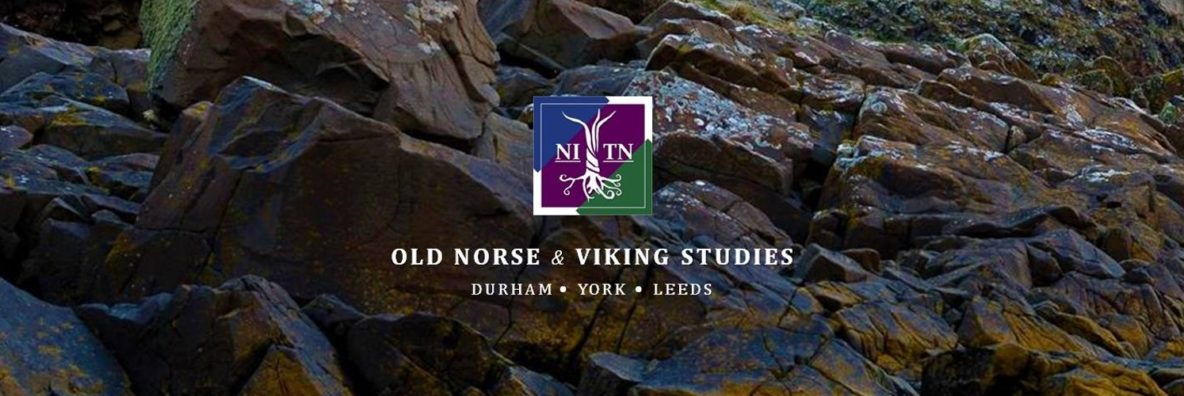This is a brief summary of the most recent Norse in the North conference (21 May 2022, York), which was funded in part by SSNS through a Postgraduate/Early Career Conference Grant.
Norse in the North is an annual conference dedicated to Viking and Medieval Studies for postgraduate and early career researchers, and is organised by postgraduate and early career researchers. From its inception, Norse in the North has fostered a leading international and interdisciplinary research community for postgraduate and early career scholars, supported by the collaboration of the universities of Durham, York, and Leeds. This year’s conference marked the decennial anniversary of Norse in the North and, with the generous support of the University of York and the Scottish Society of Northern Studies, we were able to host an event that celebrated the collegiality and collaboration that has marked this conference since its beginnings in 2012. The one-day, in-person Norse in the North conference was held at the historic Kings Manor at the University of York on 21 May 2022, bringing together an international group of postgraduate scholars from the United Kingdom and beyond – from Aberdeen to Oxford, Kentucky to York.
The theme of the conference this year – Mundanities and Mediocrities – invited scholars to reconsider the emphasis on the ‘exceptional’ in Viking and medieval Scandinavian studies. In part because of the paucity of sources, medieval studies frequently centres on certain influential individuals or particular historical moments, and scholars often celebrate the extraordinary significance of surviving medieval artefacts, manuscripts, texts, and works. We posed two questions in our Call for Papers: how might attending to the mundane and mediocre provide a both more nuanced and less destructive understanding of the Scandinavian Middle Ages? How might some of our underlying assumptions about the premodern North Atlantic be unsettled by a scholarly practice that foregrounds the common or the seemingly unremarkable? These questions provided a starting point for our three multidisciplinary panels, but what the nine attendant papers revealed was that the mundane and mediocre were sites of infinite possibility.
We began our first session, ‘Everyday Places’, chaired by Dr. Alicia Maddalena (Ph.D, York), by thinking about how the landscape could help us recover the ways in which medieval Scandinavians thought about themselves. Zach Wesley (MA, York) started our discussion by pointing us to the ways in which Viking age stone monuments, previously dismissed by scholars as unskillful or crude could function as material expressions of developing, hybrid Anglo-Danish identities in early medieval England. From there, Ellen Gipp (MA, York) revealed the ways in which attending to place-names – and particularly the place names for potentially less choice land – could help us recover how less-elite Scandinavian settlers in Viking Age Yorkshire might understand themselves. We continued our discussion of place names as James Titterington (MA, Oxford) explained how animal-based place names might be a way of navigating complex religious attitudes in medieval Iceland through a close reading of Vatnsdæla Saga.
After mingling with our attendees – which included academics, students, and members of the heritage sector – during the coffee break, we returned for our second session, ‘[Un]exceptional Genders’. Chaired by Aaron Sheldon (Ph.D, York), this panel began with Bianca Chiacchia’s (MA, York) comparative study of the lifecycle of an everyday lay woman in England and Iceland. Haley Guepet (Ph.D, Aberdeen) continued our discussion of women in the Viking Age by tracing the evolving (but tangled) way that the Gesta Danorum portrays women from shield-maidens to powerful queens, to dutiful wives. What both presentations stressed were the ways in which women expressed themselves and exerted their agency through actions overlooked by scholars as pedestrian or unimportant. Agni Agathi C. Papamichael (Ph.D, Birmingham) reminded us of the necessity of challenging ‘viking exceptionalism’ in our contemporary moment, by pointing out that popular assumptions of what Vikings looked like (blonde, white, bearded, male) lack a basis in the textual sources – which indeed, present a far more diverse and nuanced picture of Viking masculinity.
We returned from lunch for our last session of the day, ‘Disused, Disguised, Distorted’, chaired by Hannah Armstrong (Ph.D York). We began with Charlie Rhodes (M.A. York), who explored how Vikings in early medieval England transformed coins from across the Global Middle Ages into ornaments. His discussion stressed that even these seemingly everyday objects – coins – reveal the diverse and novel ways in which identity was expressed during the Viking Age. We continued thinking about ornamentation with Matthew Malone (Ph.D Durham), who considered the transformation of birch bark into a romantic disguise through a close reading of the ‘bark-man’ episode in Örvar-Odds Saga. The panel closed with a different kind of disguise – the adoption and appropriation of Viking aesthetics by white supremacist groups. Chad White (MA, University of Louisville) brought us into the present, demonstrating the urgency of challenging the ‘Viking exceptionalism’ at the heart of online radicalization movements.
Our conference closed with a keynote by Dr. Christopher Callow (University of Birmingham) entitled: “So Normal They Had to Mention It? Narration and averageness in Old Norse Icelandic Texts”. His wide-ranging talk – anchored by the Old Norse prefix for ‘averageness’ meðal- – guided us through what it meant to be ‘average’ in the Icelandic Middle Ages, raising questions about how texts composed by elites can possibly reveal the everyday lives of normal people. This talk – and its lively Q&A – was a perfect capstone to the conference, demonstrating the necessity of an interdisciplinary approach to the medieval North Atlantic and the necessity of continuing to try and uncover the ‘normal’ from the exceptional.
Delivering the closing remarks for the conference, Becca Drake (Ph.D York) summarised the working hypothesis of this conference: that by approaching the mundane and mediocre, we can work towards a more nuanced understanding of the medieval past. From our perspective as organisers, each of our presenters proved that hypothesis. But we were also thrilled to hear from our participants that Norse in the North not only aided in their understanding of the Viking Age, but also that this conference offered a space for interdisciplinary, cross-institutional, and international dialogues and collaborations. We want to once again express our gratitude for the support of the Scottish Society of Northern Studies in helping facilitate this lively discussion. Thank you.
Authored by Basil Arnould Price, Aaron Sheldon, and Hannah Armstrong.


